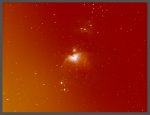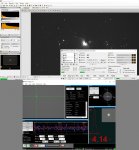steven_usa
Well-known member
Greetings! I am now trying wider field work with an ES ED80mm scope using a ZWO ASI1600MC-C (yes, OSC). I've gotten several good results with this equipment and the amazing processing workflow of PI.
Recently I tried collecting data on M42 while the moon was about at 1/3rd of full moon. I know good advise is to just NOT image DSOs when the moon is out -- but the weather was otherwise excellent, I couldn't resist to try for practice. Since as another thing: my Auto Guider solution is currently not available, and so I wanted to see what I could do with unguided 60 second exposures (which only later I remembered this would mean no Dithering, or at least I haven't setup SGP to have a dithering solution when not guiding). I think it can work (i.e. 180x60" versus 18x600" can both work) , but processing 100+ Lights does get much more tedious (for my old 8-core i7).
Maybe what I am seeing is more atmospheric gradient from my suburban Orange-zone area (where I do try to avoid imaging once things get below about 30deg above the horizon). But the scope was in the general direction of the moon, and the gradient seemed worse the next evening (where the moon was even brighter). I ended up with about 4 exposure hours total across two nights.
I've tried to apply ABE and DBE, but without success for this gradient. I am uploading two samples, one with a 60 minute integration (60x60sec) and another with the "full" integration of 236x60sec. There are basically there main problems with the image:
1) The lack of guiding can be noticed. In the 60 minute integration, I did manually select what I thought were the best frames (I know there are some automated processing to quantitatively decide which Lights are "good" but I just manually checked them out in Blink, and pruned out any frames with "bounced" stars or any jitter/elongations of stars -- completely subjective). I'm curious if there is a way to "tame" the round-ness of these stars, post integration.
2) The gradient across the left side, which is the main topic for this discussion. One question I have here is: does the order of the integration matter? (like inserting the 1st day then 2nd day, or can they all be mixed in any order and still get the same processing result?).
3) I bit of halo/glaring around the stars. I don't have my auto-focuser connected up for this ED80, so the focus knob was kept as-is throughout the two evenings. I don't know if the halo-effect is from being slightly out of focus, or if it's something else entirely (I used only a UV/IR filter). With OSC, I believe what needs to be done is to split the RGB channels and do some manual intervention? Is there any other "easier" option?
Very much appreciate anyone who has some time to try to stretch this sample integration.
For more background:
I Calibrated FLATS using the Master BIAS. So the integrated image is: DARK + FLAT (w/ BIAS) + LIGHT. Lights were calibrated (w/ DARK + FLATS), then Debayer, StarAlignment, final ImageIntegration.
box.com shared linked:
 app.box.com
app.box.com
ALTERNATIVE, dropbox:
 www.dropbox.com
www.dropbox.com
60x60:
 www.dropbox.com
www.dropbox.com
236x60:
 www.dropbox.com
www.dropbox.com
Recently I tried collecting data on M42 while the moon was about at 1/3rd of full moon. I know good advise is to just NOT image DSOs when the moon is out -- but the weather was otherwise excellent, I couldn't resist to try for practice. Since as another thing: my Auto Guider solution is currently not available, and so I wanted to see what I could do with unguided 60 second exposures (which only later I remembered this would mean no Dithering, or at least I haven't setup SGP to have a dithering solution when not guiding). I think it can work (i.e. 180x60" versus 18x600" can both work) , but processing 100+ Lights does get much more tedious (for my old 8-core i7).
Maybe what I am seeing is more atmospheric gradient from my suburban Orange-zone area (where I do try to avoid imaging once things get below about 30deg above the horizon). But the scope was in the general direction of the moon, and the gradient seemed worse the next evening (where the moon was even brighter). I ended up with about 4 exposure hours total across two nights.
I've tried to apply ABE and DBE, but without success for this gradient. I am uploading two samples, one with a 60 minute integration (60x60sec) and another with the "full" integration of 236x60sec. There are basically there main problems with the image:
1) The lack of guiding can be noticed. In the 60 minute integration, I did manually select what I thought were the best frames (I know there are some automated processing to quantitatively decide which Lights are "good" but I just manually checked them out in Blink, and pruned out any frames with "bounced" stars or any jitter/elongations of stars -- completely subjective). I'm curious if there is a way to "tame" the round-ness of these stars, post integration.
2) The gradient across the left side, which is the main topic for this discussion. One question I have here is: does the order of the integration matter? (like inserting the 1st day then 2nd day, or can they all be mixed in any order and still get the same processing result?).
3) I bit of halo/glaring around the stars. I don't have my auto-focuser connected up for this ED80, so the focus knob was kept as-is throughout the two evenings. I don't know if the halo-effect is from being slightly out of focus, or if it's something else entirely (I used only a UV/IR filter). With OSC, I believe what needs to be done is to split the RGB channels and do some manual intervention? Is there any other "easier" option?
Very much appreciate anyone who has some time to try to stretch this sample integration.
For more background:
I Calibrated FLATS using the Master BIAS. So the integrated image is: DARK + FLAT (w/ BIAS) + LIGHT. Lights were calibrated (w/ DARK + FLATS), then Debayer, StarAlignment, final ImageIntegration.
box.com shared linked:
Box
ALTERNATIVE, dropbox:
Dropbox - File Deleted - Simplify your life
60x60:
Dropbox - File Deleted - Simplify your life
236x60:
Dropbox - File Deleted - Simplify your life
Attachments
Last edited:





